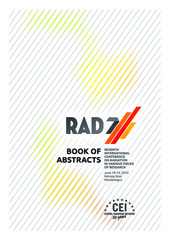Приказ основних података о документу
Airborne uranium assessment by epiphytic lichen species in contaminated areas
| dc.creator | Radenković, Mirjana | |
| dc.creator | Milošević, Sanja | |
| dc.creator | Stanković, Srboljub | |
| dc.creator | Joksić, J. | |
| dc.creator | Onjia, Antonije | |
| dc.date.accessioned | 2024-01-15T09:35:09Z | |
| dc.date.available | 2024-01-15T09:35:09Z | |
| dc.date.issued | 2019 | |
| dc.identifier.isbn | 978-86-901150-0-6 | |
| dc.identifier.uri | http://TechnoRep.tmf.bg.ac.rs/handle/123456789/7099 | |
| dc.description.abstract | Natural uranium, consisting of 238U, 234U and 235U isotopes is present in the environment in low concentrations especially in the atmosphere where it usually exists as a constituent of particulate matter submicron conglomerates suspended in the air. In the case of contamination, uranium may be present in the aerosol, being transferred to other areas by wind and again settled on the surface soil with possible migration into deeper layers or resuspension under certain meteorological conditions. Here results on the airborne uranium assessment based on the analysis of lichen species already present or transplanted into contaminated areas will be presented. With that aim, different in situ and transplanted epiphytic lichen species have been taken at selected locations in southern Serbia in the stage of existing contamination by depleted uranium, during the clean-up activities and afterwards, in all four seasons. Collected samples underwent analysis by sensitive nuclear analytical techniques. The INAA and ICP MS results are derived from 238U mass fraction while high resolution alpha-spectrometry gave results for each isotope expressed as specific activity concentration (Bq kg-1). Based on the isotopic ratios 235U /238U and 234U /238U, depleted uranium content was possible to distinguish from natural uranium in the samples. Results have shown that the sensitivity of the examined morphologically different lichen types and their ability to accumulate metals including uranium, strongly depend on metals’ concentration in the air as well as on the age of lichens, properties of host species, chemical properties of particles, local climate conditions, exposure time etc. Epiphytic lichen species Evernia prunastri was found to be the most suitable bioindicator for the accumulation of uranium airborne particles. Concerning the uranium content, a significant difference in concentrations had been observed for different sampling phases, with maximum depleted uranium contribution during the clean-up activities. The variability in uranium concentrations was noticeable in relation to prevailing wind direction, position and distance of the sampling points. Having in mind the results obtained within the national radioactivity monitoring program 2011-2017, it may be concluded that for detailed airborne uranium assessment, a methodology such as biomonitoring with the application of sensitive nuclear techniques should be considered. | sr |
| dc.language.iso | en | sr |
| dc.publisher | Niš : RAD Centre | sr |
| dc.rights | openAccess | sr |
| dc.rights.uri | https://creativecommons.org/licenses/by/4.0/ | |
| dc.source | Book of abstracts / Seventh International Conference on Radiation in Various Fields of Research, RAD 7, RAD 2019, 10-14.06.2019 Herceg Novi, Montenegro | sr |
| dc.title | Airborne uranium assessment by epiphytic lichen species in contaminated areas | sr |
| dc.type | conferenceObject | sr |
| dc.rights.license | BY | sr |
| dc.citation.spage | 419 | |
| dc.identifier.fulltext | http://TechnoRep.tmf.bg.ac.rs/bitstream/id/19430/bitstream_19430.pdf | |
| dc.identifier.rcub | https://hdl.handle.net/21.15107/rcub_technorep_7099 | |
| dc.type.version | publishedVersion | sr |

